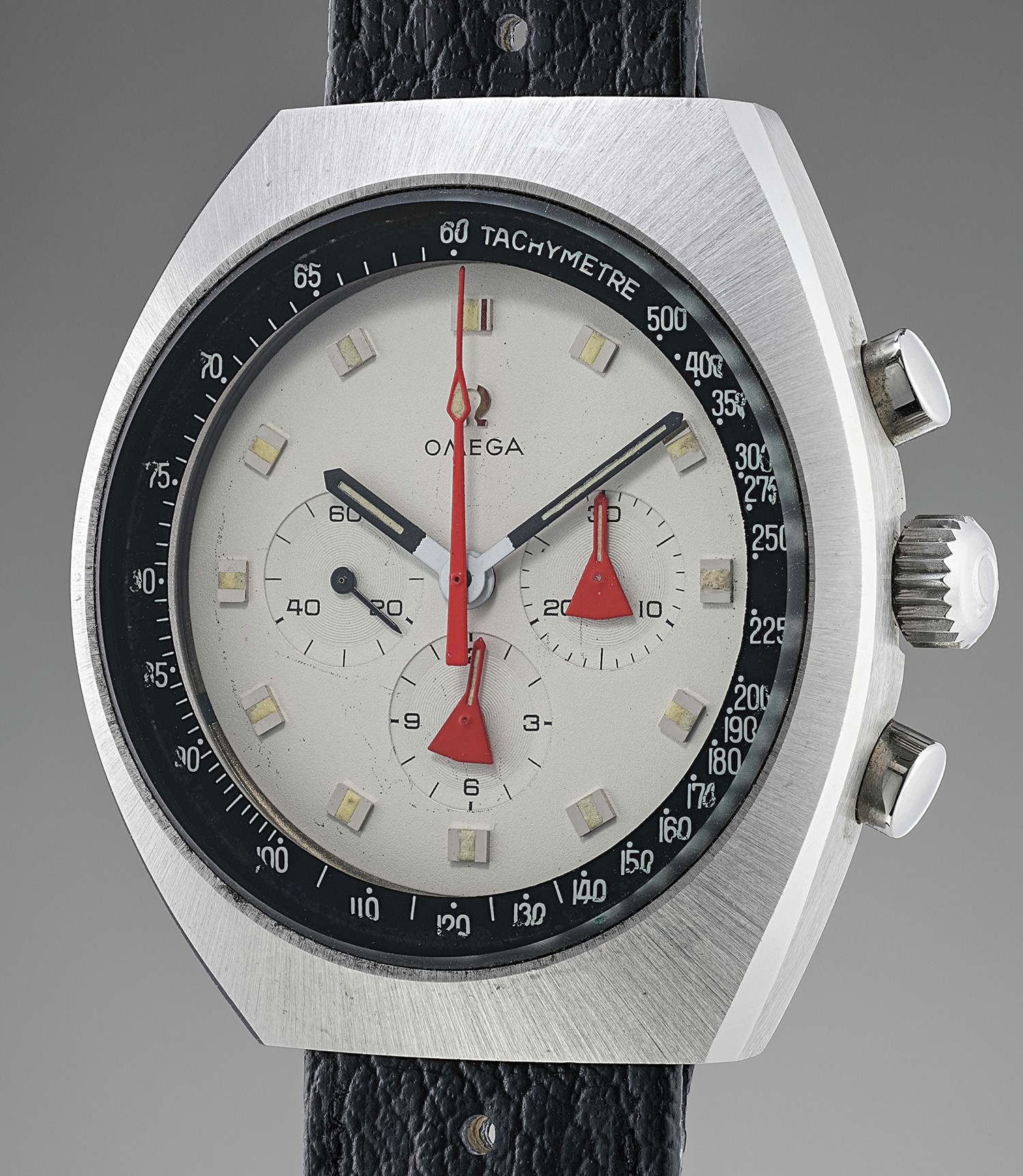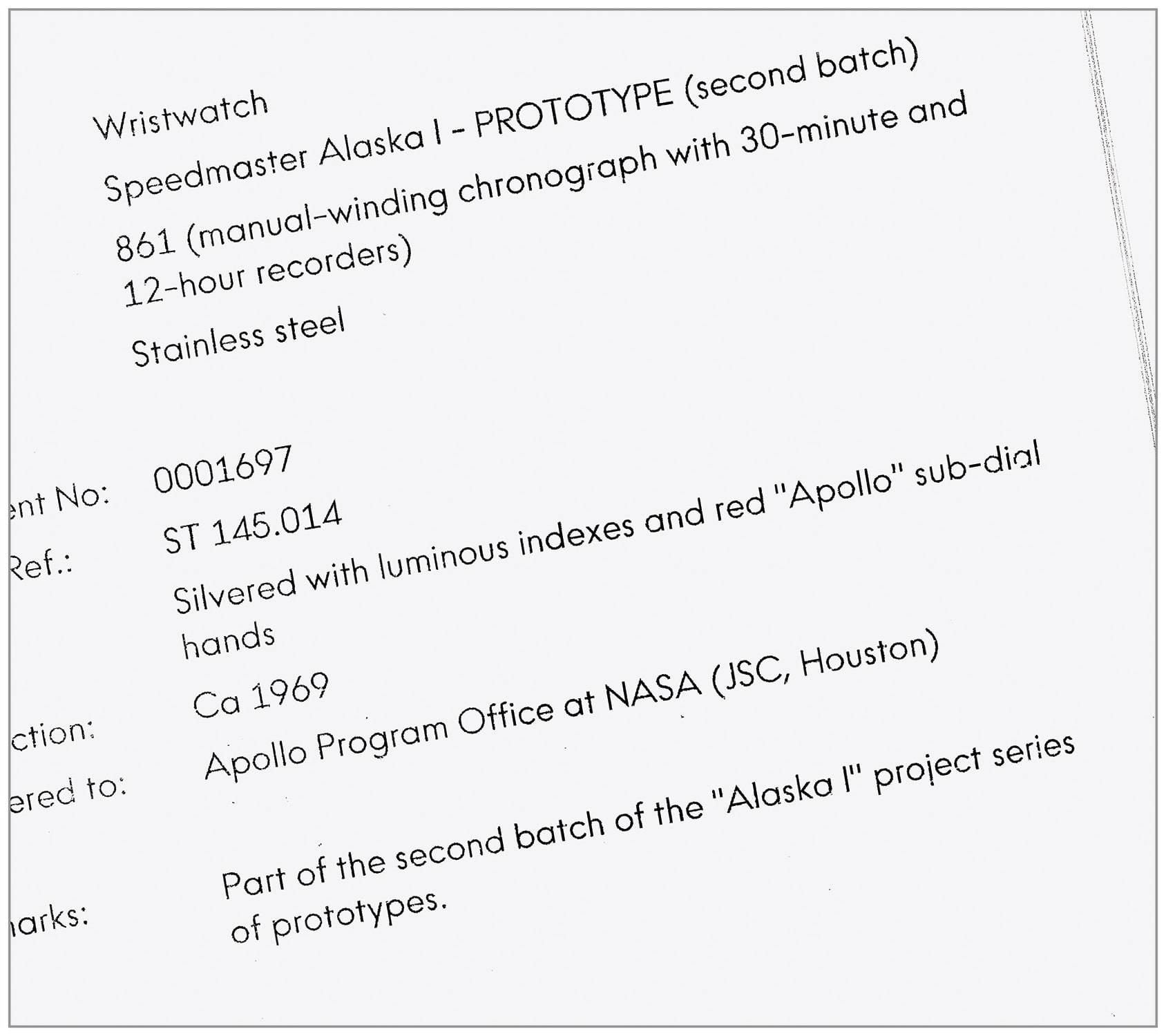







36
Omega
Ref. ST 145.014
Speedmaster Alaska I
An extremely rare, fine and historically important stainless steel prototype astronaut's wristwatch with white dial, delivered to NASA
- Estimate
- CHF40,000 - 60,000€35,200 - 52,800$41,000 - 61,500
CHF193,750
Lot Details
- Manufacturer
- Omega
- Year
- Circa 1970
- Reference No
- ST 145.014
- Movement No
- 0'001'697
- Model Name
- Speedmaster Alaska I
- Material
- Stainless steel
- Calibre
- Manual, cal. 861, 17 jewels
- Bracelet/Strap
- Leather
- Clasp/Buckle
- Stainless steel Omega pin buckle
- Dimensions
- 45.5mm Length, 42mm Width
- Signed
- Case, dial, movement and buckle signed
- Accessories
- Accompanied by Omega Extract from the Archives confirming production of the present watch in Circa 1970 as part of the third and last batch of the "Alaska I" project series of prototypes, and its subsequent delivery to the Apollo Program Office at NASA (Houston).
Specialist
Full-Cataloguing
Catalogue Essay
In 1968, NASA engineer James Ragan approached Omega with the idea of creating a dedicated “Lunar Surface Chronograph”. Mr. Ragan was the same engineer who oversaw the 1965 tests which selected the Speedmaster as NASA’s official timepiece, and he was therefore very well acquainted with the model. Still, he was worried that the longer EVAs (“Extra Vehicular Activities”) on the lunar surface might prove excessive even for the qualified Speedmaster.
This was the beginning of the “ALASKA” project, so named following the internal tradition of code-naming watch developments with the names of cities, countries or states. Contrary to widespread urban legends, this name had indeed absolutely nothing with the low temperatures encountered in the State of Alaska.
Many iterations of “ALASKA” projects came to be, but the present lot is a representative of the legendary “ALASKA I” project.
Produced in 1969 and delivered to Mr. Ragan at NASA for testing, “ALASKA I” was a series of prototypes involving not only one of the first, if not the first, titanium-cased chronographs, but also a version of Omega ́s calibre 861 that featured numerous modifications to ensure better resistance to extreme temperature changes.
Such a technologically advanced project accumulated extremely high costs, and the first iteration of the “ALASKA I” became unbearably expensive. Omega thus created a follow-up design in order to achieve the same results but while trying to keep the costs within reasonable levels. The case of this project was modeled after the then new Speedmaster “Mark II”, but this is where all similarities between the two models end: other than the case, literally nothing remained the same between this second series of “ALASKA I” prototypes and the Speedmaster “Mark II”.
While the first series of “ALASKA I" features a black dial, a silvery-white dial was now chosen for its reflective capabilities. The chronograph sub-dial hands were maintained unaltered: the shape of these hands ensures legibility even while the watch sustains extreme vibrations, while any other regular hand under the same conditions would literarily blur out of sight. As with the very first version, the caliber 861 of this second “ALASKA I” version received many technical fine-tuning including the pioneering use of novel lubricants that ensured perfect operation even under extreme conditions in space.
Another noteworthy detail is the crystal: during the 1965 tests, Mr. Ragan was very clear that he only accepted acrylic, plexi or hesalite crystals that would not shatter in many small pieces. In order to be able to provide better environmental sealing, Omega reverted to mineral crystal for all variants of the “ALASKA I” project, a fact at first regarded with adequate suspicion by Mr. Ragan himself. After several tests, however, the new crystal was proven more than adequate, with Mr. Ragan later recalling humorously that, try as he might, he could not get the crystals to break.
With the approaching of Apollo 11 and the moon landing, the project was eventually cut short thus restricting production to few precious prototypes.
This watch is an incredible chance for collectors of rare and highly important timepieces alike to acquire a true piece of history: one of the very few - possibly the only - surviving examples of “Mark II” prototypes of Omega ́s legendary “ALASKA I” project.
We sincerely thank Petros Protopapas of Omega and the Omega Museum for their invaluable research on the present lot.
This was the beginning of the “ALASKA” project, so named following the internal tradition of code-naming watch developments with the names of cities, countries or states. Contrary to widespread urban legends, this name had indeed absolutely nothing with the low temperatures encountered in the State of Alaska.
Many iterations of “ALASKA” projects came to be, but the present lot is a representative of the legendary “ALASKA I” project.
Produced in 1969 and delivered to Mr. Ragan at NASA for testing, “ALASKA I” was a series of prototypes involving not only one of the first, if not the first, titanium-cased chronographs, but also a version of Omega ́s calibre 861 that featured numerous modifications to ensure better resistance to extreme temperature changes.
Such a technologically advanced project accumulated extremely high costs, and the first iteration of the “ALASKA I” became unbearably expensive. Omega thus created a follow-up design in order to achieve the same results but while trying to keep the costs within reasonable levels. The case of this project was modeled after the then new Speedmaster “Mark II”, but this is where all similarities between the two models end: other than the case, literally nothing remained the same between this second series of “ALASKA I” prototypes and the Speedmaster “Mark II”.
While the first series of “ALASKA I" features a black dial, a silvery-white dial was now chosen for its reflective capabilities. The chronograph sub-dial hands were maintained unaltered: the shape of these hands ensures legibility even while the watch sustains extreme vibrations, while any other regular hand under the same conditions would literarily blur out of sight. As with the very first version, the caliber 861 of this second “ALASKA I” version received many technical fine-tuning including the pioneering use of novel lubricants that ensured perfect operation even under extreme conditions in space.
Another noteworthy detail is the crystal: during the 1965 tests, Mr. Ragan was very clear that he only accepted acrylic, plexi or hesalite crystals that would not shatter in many small pieces. In order to be able to provide better environmental sealing, Omega reverted to mineral crystal for all variants of the “ALASKA I” project, a fact at first regarded with adequate suspicion by Mr. Ragan himself. After several tests, however, the new crystal was proven more than adequate, with Mr. Ragan later recalling humorously that, try as he might, he could not get the crystals to break.
With the approaching of Apollo 11 and the moon landing, the project was eventually cut short thus restricting production to few precious prototypes.
This watch is an incredible chance for collectors of rare and highly important timepieces alike to acquire a true piece of history: one of the very few - possibly the only - surviving examples of “Mark II” prototypes of Omega ́s legendary “ALASKA I” project.
We sincerely thank Petros Protopapas of Omega and the Omega Museum for their invaluable research on the present lot.
Omega
Swiss | 1848Omega's rich history begins with its founder, Louis Brandt, who established the firm in 1848 in La Chaux de Fonds. In 1903, the company changed its name to Omega, becoming the only watch brand in history to have been named after one its own movements. A full-fledged manufacturer of highly accurate, affordable and reliable watches, its sterling reputation enabled them to be chosen as the first watch company to time the Olympic Games beginning in 1932. Its continued focus on precision and reliability ultimately led their Speedmaster chronograph wristwatch to be chosen by NASA in 1965 — the first watch worn on the moon.Key models sought-after by collectors include their first, oversized water-resistant chronograph — the reference 2077, early Speedmaster models such as the CK 2915 and 2998, military-issued versions of the Seamaster and oversized chronometer models such as those fitted with their prestigious caliber 30T2Rg.
Browse Maker